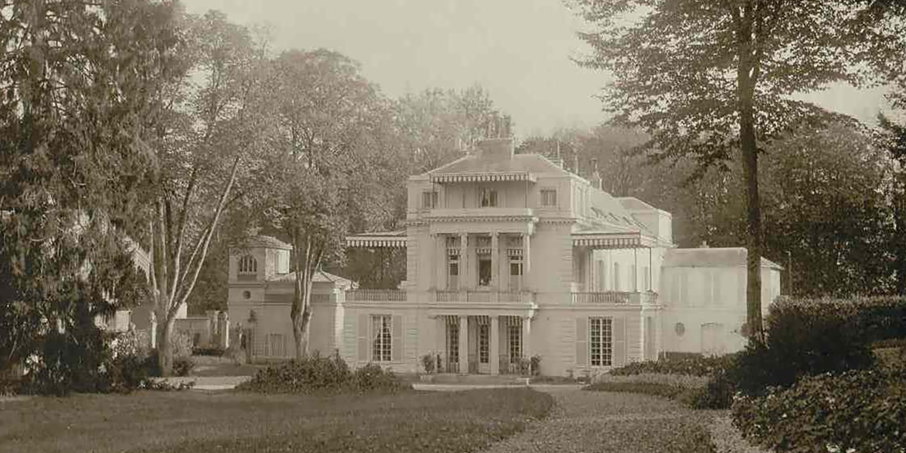Situation of the evolution of the village of Yerres
Known since the Middle Ages, the village of Yerres, although with an agricultural vocation, has always attracted rich owners, often close to royal power. This explains the presence of an important heritage composed of castles and monasteries, still present or in the form of vestiges. The proximity of the capital determined a particular enthusiasm among the aristocrats, then the upper middle class, for the Yerres valley, appreciated as a real tourist site. Indeed, on the banks of the river there are numerous landscaped parks, these pleasure gardens in the “English” style, dotted with ornamental factories.
Heritage and history of the Caillebotte Property
The Caillebotte Property was developed around 1830
(bringing the park to an area of more than 11 hectares) by Pierre Frédéric Borrel, the chef of the very famous restaurant Au Rocher de Cancale, the most prestigious restaurant in Paris.
Nothing was too good for this character, known to Balzac and worthy of his novels: Borrel was proud to show off what the chronicle of the time described as an “architectural masterpiece”. Today we can recognize most of the ornamental “factories” built by the owner: the Italian Casin and its beautiful Palladian colonnade, the Exèdre and its antique statues, the elegant kiosk, in oriental style, which surmounts the ice house. , the cottage, the neo-classical Orangery in the manner of the great architects who decorated many Parisian monuments, and the agricultural buildings constituting the Ferme Ornée (stables, cow shed, dairy, barns, aviaries, farmyard, etc. ).
In 1825 Borrel published his “New Dictionary of Cuisine, Office and Pastry”.
An old guide from this time praises Borrel's Yerre property in flattering and ironic terms: "Gastronomes by car, who frequent the Rocher de Cancale, can go and visit the enchanted residence of Balaine's successor: this masterpiece of architecture, according to the desire of the owner, erases the most elegant houses of all its neighbors; some are peers of France, bankers, etc. A library of 6000 volumes, of which we do not, however, guarantee the choice, a mirror costing 8000 francs, in a boudoir, furniture of infinite price, and of the most novel taste, will prove to the curious how far the little one can go glory of a good cook, and how much he had to increase his restaurant's menu to cover similar expenses. Mr. Borrel truly is the Rothschild of Gastronomy. (…) »
It was between 1824 and 1843 that Pierre Frédéric Borrel farmed more than 50 hectares in Yerres located in the Prairie which extends his property to Montgeron. Borrel was 55 years old in 1843. The bankruptcy of Rocher de Cancale was widely commented on throughout Paris at the time. The fate of the great restaurateur still remains unknown.
The owners
- Around 1600 : Nicolas Budé, heir to the lords of Yerres, constitutes the fiefdom of Narelles, part of which will become the Caillebotte property
- From the French Revolution onwards, division of large estates
- From 1824 to 1843 Pierre Frédéric Borrel is developing the nearly 12 hectare estate
- From 1843 to 1860 Madame Biennais, widow of the famous goldsmith and table maker of the Empire, resides there; his heirs sold the whole to Martial Caillebotte, father of the painter.
The Caillebotte family, rich Parisians in the countryside
Mr. Martial Caillebotte made the Yerrois estate one of their summer residences, far from the major works of Baron Haussmann transforming Paris: from 1860, he had new factories built (Romanesque-Gothic chapel, Swiss chalet, rotunda aviary) , enlarged the vegetable garden, built a small private wash house at the water's edge and a very beautiful pier covered in tiles, he embellished the park with baskets and flowered paths, all very well maintained by five gardeners.
1879 : after the death of their father in 1874 and their mother in 1878, Alfred, Gustave and Martial Caillebotte sold the Yerroise property to Parisians Mr and Mrs Dubois.
- 1963 : Madame Dubois, daughter, sells to Mr. Paul Chaslin, director of the GEEP company which constructs school buildings. This maintains the park and extends the buildings of the Ferme Ornée, which today house the Art and Exhibition Center.
- 1971 : following a legal settlement by the GEEP Industries Company, and as part of a real estate project, the town of Yerres acquired, for a symbolic franc, in 1973 the entire estate.
She had most of it classified in 1975, then in 1993, the main buildings and factories were listed on the Supplementary Inventory of Historic Monuments. - Since 1995, the commune of Yerres is working to rehabilitate this exceptional heritage.
- 2012 : The Property is labeled “Maison des Illustres” by the Ministry of Culture.
The ornamental factories (Casin, Orangerie, Kiosk and Glacière), witnesses to the layout of the estate then designed as an English garden, have been gradually restored.
The park, for its part, benefited from the talent of landscaper Louis Benech, who replanted it and restored the water features.
The vegetable garden, maintained with passion by a Yerre association, was enlarged in 2011, but only represents a third of its original surface area. The painter liked to grow flowers and fruits there.
Gustave Caillebotte is known to have been a great patron. Also the city wanted its property to host an Art and Exhibition Center open to contemporary artists.









